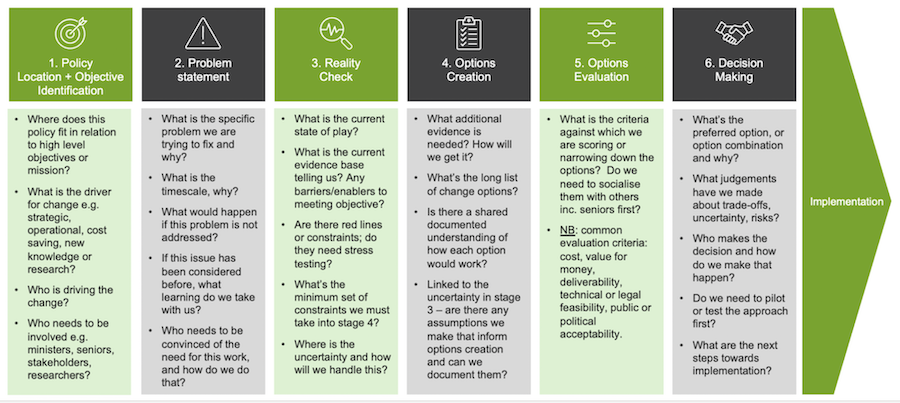The early stages of the policy-development cycle can be overwhelming. Here's a framework to help
A new governing party brings with it big changes for civil service policymakers. For some, it will mean a re-evaluation, reprioritisation or intensification of existing work programmes. For others, it will involve creating new policy from first principles and – given the speed at which the Labour government appears to be moving – at significant pace!
From my experience of leading in departments such as DESNZ and (formerly) BEIS, teams can find the early stages of the policy-development cycle difficult at times, even overwhelming. They may be unsure where to start or how to incorporate ministerial wishes, departmental objectives, stakeholder views, data and research outputs, technical knowhow and policy knowledge into the work while also identifying the policy options and key decisions to drive progress. In newly established teams – an obvious characteristic of a new government – some staff will be completely new to the subject.
A quick google of "policy development" reveals a myriad of detailed information online. But what seems to be missing is set of high-level prompts that teams can use to drive work at greater depth, connect the thinking, link stakeholder engagement with use of evidence, identify uncertainties and trade-offs and move to decision making.
The Developing Options Pathways framework (at the bottom of this article) is my attempt to support policy teams with this. It guides the user through six mini-stages of policy development (all prior to implementation) using key questions to stimulate thinking to move from first principles to identification of frontrunner options. Not all the stages need to be followed sequentially; several (1-3) can be progressed in parallel with some reconciliation in between. And, given policymaking in government is rarely linear, the framework provides agility so that if circumstances or priorities change, the knowledge and findings can be easily refreshed across each mini-stage and rolled into updated outputs or options.
So, what advice would I give to teams as they embark upon a policy-development journey?
- Take time to understand the strategic context. Sometimes teams jump straight to problem identification without considering what or who is driving the change and why. The political (small "p") context may be critical to the choice of final policy options, so should be understood and documented early on. For example, if a minister has commissioned the work, talk to their private secretary to discover background, expectations, red lines…
- Feel empowered and be curious. If you are asked to lead on a policy or an aspect of it, own it! What might seem like a silly question can stimulate deeper thinking, even amongst experts. Use your curiosity to constructively challenge the status quo, test out an opposite view or explore possible solutions.
- Reach out. Unless the subject is highly sensitive or restricted, I advise speaking to a variety stakeholders (such as industry experts, academics, researchers, regulators, engineers, consumer groups, NGOs) throughout the process. This will drive diversity of thought, challenge your own thinking and help you discover what the stakeholder community already knows or is able to contribute.
- Focus on what you know, (not what you don’t). As you learn about an issue, it’s possible to get overwhelmed – paralysed even – by what you don’t know. Make a plan for capturing the gaps and readjusting when you know more, but don’t let it take you away from progressing what you do know.
- Stress test. The best policy solutions come from a process of creation, feedback, iteration and pragmatism. You do not need to find the perfect answer first time – offer ideas up, share them widely and diversely (you can caveat this as "initial thinking") and be ready to refine them following feedback.
- Decide how you will handle gaps in the evidence base. By evidence base, I mean all the types of tangible information that can support decision making, like modelling and poll data, research outputs, consultation responses, stakeholder views, market and technical intelligence, and government statistics. In my experience, the evidence base in one segment rarely matches 100% of policy needs, but cumulative findings across segments can identify trends and drive pragmatic solutions. Identifying where the gaps are and how you will handle them is critical to robust policymaking.
- Ministers will need to know about risks and trade-offs. As evidence- and rationale-based advice is put to ministers, teams often focus on articulating the upsides of the recommendations. But for full transparency, it’s important to make ministers aware of the downsides too. Be sure to specify the risks linked to the recommendation – what might come back to bite? – and the trade-offs – the things you have you had to sacrifice or deprioritise to move forward. By doing this you are supporting your minister to take the decision based on an holistic view of the issue or situation.
Policy development: developing options pathways
 Clare Dobson is an independent policy consultant. She is a former senior civil servant with over 20 years’ experience of policymaking.
Clare Dobson is an independent policy consultant. She is a former senior civil servant with over 20 years’ experience of policymaking.